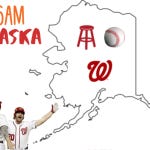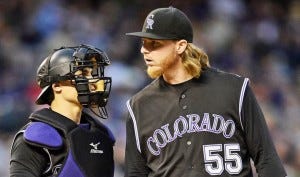Ranking MLB Rotations Part 2: How Are These Not The Worst?
If you missed part 1… click here
You’ll see 7 more of these over the next week & I hope you enjoy them all. I know these are long so I’ve bolded all of the relevant pitcher names. I’d really love to talk with you all about the rankings or baseball in general in the comments or on twitter.
30. San Diego Padres
29. Cincinnati Reds
28. Minnesota Twins
27. Miami Marlins
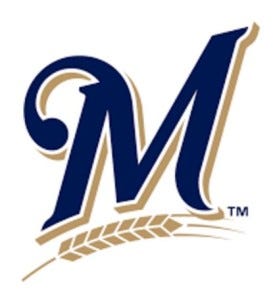 26. Milwaukee Brewers The Brewers rotation is more a collection of 4th and 5th starters than anything else. There isn’t much potential to be had, and its almost astonishing that there are 4 teams with rotations worse than this.
26. Milwaukee Brewers The Brewers rotation is more a collection of 4th and 5th starters than anything else. There isn’t much potential to be had, and its almost astonishing that there are 4 teams with rotations worse than this.
Junior Guerra was a major success story last year but it just doesn’t seem very realistic for him to repeat his performance in 2017. The 32 year old pitched to a 2.81 ERA in 121.2 innings last season, but lucked out with a low opponent BABIP and a high LOB%. Among pitchers with at least 120 innings pitched, his BABIP was 4th lowest and his Left on base % (LOB%) was 15th highest – LOB% in particular has a huge variance from year to year meaning that pitchers aren’t really able to control these things very well. Behind Guerra is 24 year old righty Zach Davies (pictured).  A rookie last season, Davies pitched to a sub-4.00 ERA, FIP, and xFIP while limiting the walks – he had the 13th lowest BB%, walking batters in just 5.6% of plate appearances. I like young pitchers who know how to avoid the free pass, and fangraphs comparing Davies to the Cubs’ Kyle Hendricks just adds to his luster. I’d be surprised if this guy isn’t the Brewers top starter by season’s end. Jimmy Nelson is 27, walks a ton of batters, and has terrible peripherals, Wily Peralta is 27, hardly ever strikes out anyone, and has a very bad ERA and FIP, and Matt Garza is 33 and is a perfect blend of the negatives of Nelson and Peralta, but with an added dose of contraceptive hatred. Yup, that’s Milwaukee’s rotation. If you want me to examine the 6th and 7th starters, I will. Chase Anderson is 29, walks a lot of guys, and has terrible peripherals; Tommy Milone is 30, hardly ever strikes anyone out, and has a very bad ERA and FIP. There. This was the easiest rotation to rank.
A rookie last season, Davies pitched to a sub-4.00 ERA, FIP, and xFIP while limiting the walks – he had the 13th lowest BB%, walking batters in just 5.6% of plate appearances. I like young pitchers who know how to avoid the free pass, and fangraphs comparing Davies to the Cubs’ Kyle Hendricks just adds to his luster. I’d be surprised if this guy isn’t the Brewers top starter by season’s end. Jimmy Nelson is 27, walks a ton of batters, and has terrible peripherals, Wily Peralta is 27, hardly ever strikes out anyone, and has a very bad ERA and FIP, and Matt Garza is 33 and is a perfect blend of the negatives of Nelson and Peralta, but with an added dose of contraceptive hatred. Yup, that’s Milwaukee’s rotation. If you want me to examine the 6th and 7th starters, I will. Chase Anderson is 29, walks a lot of guys, and has terrible peripherals; Tommy Milone is 30, hardly ever strikes anyone out, and has a very bad ERA and FIP. There. This was the easiest rotation to rank.
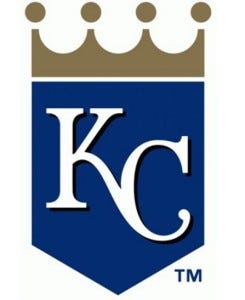 25. Kansas City Royals The Kansas City Royals reached the World Series in 2014, they won the World Series in 2015, and now they have the 6th worst rotation in all of baseball. Starting pitching had never been Kansas City’s strength but this year, the preview is particularly bad. Yordano Ventura’s heartbreaking death from a fatal car accident shocked and saddened baseball fans everywhere but also hurt the Royals’ 2017 rotation.
25. Kansas City Royals The Kansas City Royals reached the World Series in 2014, they won the World Series in 2015, and now they have the 6th worst rotation in all of baseball. Starting pitching had never been Kansas City’s strength but this year, the preview is particularly bad. Yordano Ventura’s heartbreaking death from a fatal car accident shocked and saddened baseball fans everywhere but also hurt the Royals’ 2017 rotation.
You might not find a bigger fan of Danny Duffy (pictured) than me. I LOVE the guy and have for years, his 5 year, 65 million dollar deal could be a bargain even though he probably isn’t one of the top 30 arms in the game. Duffy, now 27, has endured injury after injury and still never started more than 26 games in a season, but has finally hit his groove. In 2014, Duffy had the 5th best ERA among all American League pitchers who tossed at least 140 innings. But no one cared and, truthfully, he was still a very flawed pitcher. He didn’t strike many batters out and issued a few too many free passes. The next year, he took a 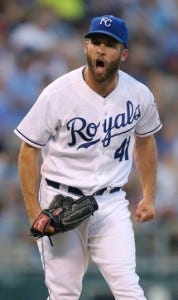 step back in almost every regard. Last season though, Duffy established himself as a legitimate force that can hang in any rotation. Duffy’s 3.51 ERA (3.86 as a starter) and even worse FIP, xFIP, and SiERA leaves a lot to be desired and a lot of room for improvement, but he finally found his stuff – striking out 9.4 batters per 9 innings (1.6 more than his career average) and walking just 2.1 batters per 9 innings (1.2 less than his career average). Duffy did have the 7th best LOB% in baseball next year, and completely faded in September (5.50 ERA), but as someone who completely neutralizes lefties (.182/.219/.229) and can handle righties, he should continue to improve in 2017. Jason Hammel signed a free agent deal with Kansas City after a successful 2.5 year stint with the Cubs. His ERA has increased in each of the past three years while his K/9 and BB/9 each got worse from 2015 to 2016. Regardless of Hammel’s decline, he is firmly a member of the Royals’ lackluster starting five. Outwardly, Ian Kennedy’s stats don’t look too bad but it’s a lot easier to have a 3.68 ERA when you’re stranding 83% of baserunners (most in the American League). If you set Kennedy’s ERA O/U at 4.00, I’d hammer the over. As lucky as Kennedy was with LOB%, Nate Karns was unlucky. Karns stranded only 69% of runners (37th worst among pitchers with 90+ innings); he’s got the strikeout stuff but will need to work on limiting the walks if he wants to hold his spot in the starting 5. Matt Strahm, a lefty reliever might be an option for the final rotation spot at some point this season (he is not being stretched out during spring training though) because we know Jason Vargas and Chris Young aren’t very good and Mike Minor hasn’t pitched in the majors since ‘14.
step back in almost every regard. Last season though, Duffy established himself as a legitimate force that can hang in any rotation. Duffy’s 3.51 ERA (3.86 as a starter) and even worse FIP, xFIP, and SiERA leaves a lot to be desired and a lot of room for improvement, but he finally found his stuff – striking out 9.4 batters per 9 innings (1.6 more than his career average) and walking just 2.1 batters per 9 innings (1.2 less than his career average). Duffy did have the 7th best LOB% in baseball next year, and completely faded in September (5.50 ERA), but as someone who completely neutralizes lefties (.182/.219/.229) and can handle righties, he should continue to improve in 2017. Jason Hammel signed a free agent deal with Kansas City after a successful 2.5 year stint with the Cubs. His ERA has increased in each of the past three years while his K/9 and BB/9 each got worse from 2015 to 2016. Regardless of Hammel’s decline, he is firmly a member of the Royals’ lackluster starting five. Outwardly, Ian Kennedy’s stats don’t look too bad but it’s a lot easier to have a 3.68 ERA when you’re stranding 83% of baserunners (most in the American League). If you set Kennedy’s ERA O/U at 4.00, I’d hammer the over. As lucky as Kennedy was with LOB%, Nate Karns was unlucky. Karns stranded only 69% of runners (37th worst among pitchers with 90+ innings); he’s got the strikeout stuff but will need to work on limiting the walks if he wants to hold his spot in the starting 5. Matt Strahm, a lefty reliever might be an option for the final rotation spot at some point this season (he is not being stretched out during spring training though) because we know Jason Vargas and Chris Young aren’t very good and Mike Minor hasn’t pitched in the majors since ‘14.
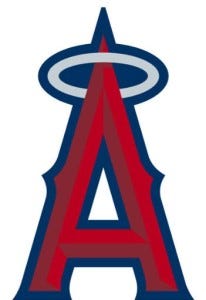 24. Los Angeles Angels This rotation is characterized by question marks. If everything goes right, the team’s rotation might rank much higher than its 23rd overall pre-season rank. But, everything rarely goes right.
24. Los Angeles Angels This rotation is characterized by question marks. If everything goes right, the team’s rotation might rank much higher than its 23rd overall pre-season rank. But, everything rarely goes right.
The team’s ace, Garrett Richards, is finally healthy and his injuries didn’t diminish his mid-90s fastball velocity but he only threw 34.2 innings last season and his stellar 2.34 ERA was not backed up by a 3.32 FIP and 3.91 xFIP. He also walks too many batters – nearly 4 batters every 9 innings (3.9/9). Lefty Tyler Skaggs is projected as the team’s #2. He threw 49.2 IP last year (after missing all of 2015) and while Skaggs did fan a batter an inning, he also walked way too many (4.2/9). Skaggs must get his pitches under control because, until he does that, he won’t be any more than a mistake-prone back-end arm. If you open a dictionary from 2011 and navigate to ‘mediocre starting pitcher,’ Ricky Nolasco’s face will probably pop up. Well, there is no need to update that dictionary because Nolasco is just as mediocre as always. He won’t be a complete black hole in your rotation but no way he adds value either. And, the 34 year old’s strikeout skills have slipped with age. 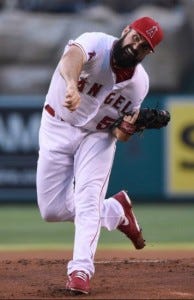 Matt Shoemaker (pictured) really changed his whole M.O last year. In the first half of the year, he was a punch-out guru, K-ing a batter an inning but allowing a run in every other frame (4.45 ERA), but then something shifted and away went the strikeouts (down to 6.57/9 innings) and down went the ERA (3.00 in the 2nd half). It remains to be seen whether 2nd half Shoemaker is the guy we should expect in 2017. It should be noted that Shoemaker’s velocity remained constant throughout the entire season. For what its worth, Shoemaker has a 4.85 ERA with 18 strikeouts in 13 innings this spring. Jesse Chavez has a shot at the final rotation spot but he isn’t anything special (sorry, Jesse!). Alex Meyer, Chavez’s competition, infuriates me. Meyer is a towering 6’9 yet he just has not figured it out – the 27 year old deserves more opportunities (especially considering how great his upside is compared to Chavez), but he might just be an example of wasted potential. Both Nick Tropeano and Andrew Heaney will miss 2017 with Tommy John surgery.
Matt Shoemaker (pictured) really changed his whole M.O last year. In the first half of the year, he was a punch-out guru, K-ing a batter an inning but allowing a run in every other frame (4.45 ERA), but then something shifted and away went the strikeouts (down to 6.57/9 innings) and down went the ERA (3.00 in the 2nd half). It remains to be seen whether 2nd half Shoemaker is the guy we should expect in 2017. It should be noted that Shoemaker’s velocity remained constant throughout the entire season. For what its worth, Shoemaker has a 4.85 ERA with 18 strikeouts in 13 innings this spring. Jesse Chavez has a shot at the final rotation spot but he isn’t anything special (sorry, Jesse!). Alex Meyer, Chavez’s competition, infuriates me. Meyer is a towering 6’9 yet he just has not figured it out – the 27 year old deserves more opportunities (especially considering how great his upside is compared to Chavez), but he might just be an example of wasted potential. Both Nick Tropeano and Andrew Heaney will miss 2017 with Tommy John surgery.
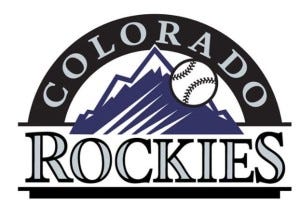 23. Colorado Rockies Coors Field is a tough place to pitch, and it’s taken a while but the Rockies seem to be establishing a sturdier group of starters. This group isn’t good compared to most other rotations, but, for Denver, it’s okay.
23. Colorado Rockies Coors Field is a tough place to pitch, and it’s taken a while but the Rockies seem to be establishing a sturdier group of starters. This group isn’t good compared to most other rotations, but, for Denver, it’s okay.
It’s no secret that no one likes to pitch in mile-high Denver and the Rockies have seemingly neglected their rotation in past years, but they’re starting to gain some legitimate talent. Chad Bettis’ cancer tragically returned and he now has much more important things to deal with than pitching. Is Tyler Chatwood good? Is he bad? Well, it’s hard to say. Chatwood’s stock is definitely up from where it was at this point last year (he missed all of 2015 with injuries), but his stock is down from an early-season high. In his first 10 outings, Chatwood induced grounders nearly 60% of the time and had a 2.69 ERA – he looked like someone that could make a name for himself. Since then? The 27 year old’s ERA increased by nearly 2 runs (to 4.67) and he walked 5 batters for every 7 that he struck out. Also amazingly, Chatwood was nails outside of Colorado (1.69 ERA in away games), but wasn’t even startable at home (6.12 ERA). The true Chatwood is probably somewhere in between the extremes with an ERA above 4.25 being much more likely than an ERA below 3.60 in 2017.
Jon Gray is BY FAR the most exciting starter in the Rockies rotation. Gray, 25, was the 3rd overall pick in the 2013 draft and, after scuffling a little in the minors, really burst onto the MLB scene with the 9th best K/9 in all of baseball (9.9K/9). Where other Rockies try to induce grounders, Gray just tries to strike everyone out – he is certainly someone to keep an eye on in 2017 because starters with 95 MPH heat should be relevant wherever they play and he was pretty unlucky with his 4.61 ERA last year – in fact, FIP, xFIP, and SiERA all agree it should have been closer to 3.61 than 4.61. Lefty Tyler Anderson was a 26 year old rookie last season and put up pretty good looking numbers (particularly a 3.54 ERA and 3.5 strikeouts per every walk). It’s tough for me to trust a relatively unknown mid-20s starter to remain consistent in Colorado but Anderson was actually more effective in Denver than elsewhere. His 3.00 ERA in 78 innings is remarkable and his performance out of the stretch signals to me that maybe the Rockies have something here. Batters hit just .232/.270/.407 with runners on base (compared to .293/.354/.435 with the bases empty). 24 year old Jeff Hoffman, the 9th overall pick in 2014, started 6 games for Colorado last year but struggled mightily – he was optioned to AAA and he’ll need to get it  together if he wants to be a MLB starter. German Marquez (pictured), just 22, has limited MLB experience but his mid-90s sinker fits with Coors Field and he pitched exquisitely in AA at a very young age last season. Marquez will expand his secondary offerings with age but he’s an interesting back-end option with youth on his side. Harrison Musgrave, 25, has not yet reached the majors, but has had a strong spring and could be in the mix. Kyle Freeland, coincidentally selected immediately before Jeff Hoffman in 2014, looked like only a mid-season call-up but a strong spring has him in the mix for the 5th spot – he doesn’t have strikeout stuff but could be relatively effective nonetheless.
together if he wants to be a MLB starter. German Marquez (pictured), just 22, has limited MLB experience but his mid-90s sinker fits with Coors Field and he pitched exquisitely in AA at a very young age last season. Marquez will expand his secondary offerings with age but he’s an interesting back-end option with youth on his side. Harrison Musgrave, 25, has not yet reached the majors, but has had a strong spring and could be in the mix. Kyle Freeland, coincidentally selected immediately before Jeff Hoffman in 2014, looked like only a mid-season call-up but a strong spring has him in the mix for the 5th spot – he doesn’t have strikeout stuff but could be relatively effective nonetheless.
Be on the lookout for part 3 tomorrow!
Follow @SAlaskaBarstool
